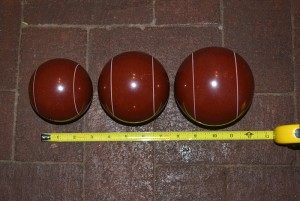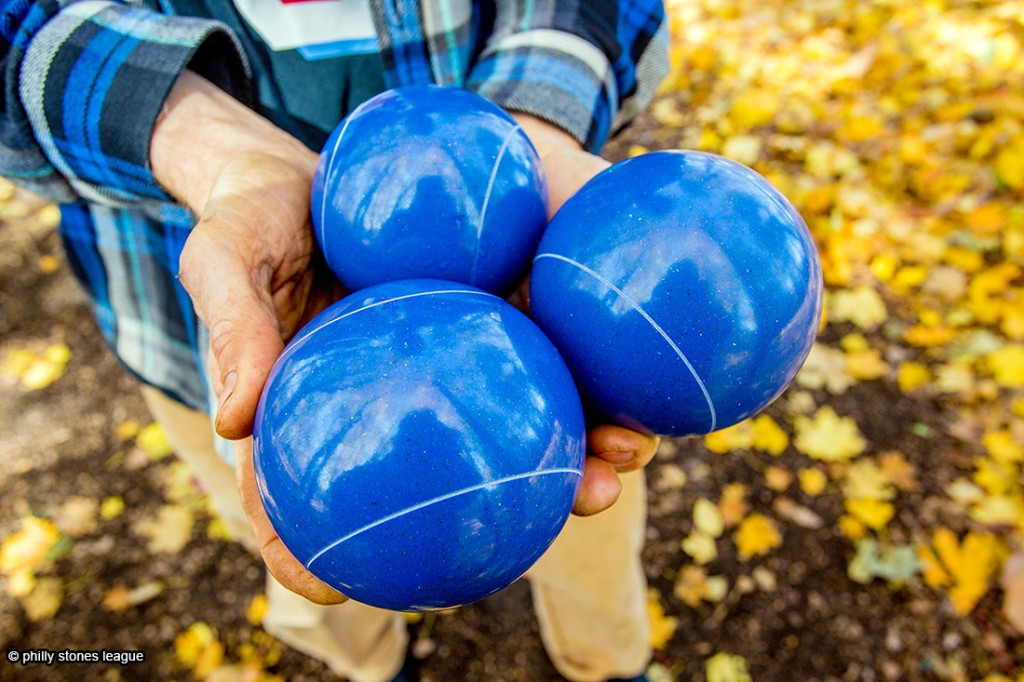Does size matter? In certain circumstances, this is a hotly-debated question. In the game of Stones, not so much. In your bucket sits four stones: one at 90 millimeters in diameter, two at 100 millimeters and one at 110 millimeters. While the difference is subtle, size definitely does matter. During each round of play, two of your four stones are thrown. Which two you choose could result in the difference between scoring 6 points or watching your opponent do so. Choose wisely.
All things being fairly equal (a semi-level playing field, no low hanging branches etc.) it is probably best to throw your two 100mm stones as often as possible to get fully accustomed to their size and weight. These are your “go to” stones and in most cases do quite well. Also, unless there is some strange circumstance where you would throw a big (110 mm) and a small (90mm) as your two stones (very rarely advisable) , you will have to throw at least one 100 mm stone each and every round. Knowing this stone well will be of great service to you. With beginners, it is recommended to throw 100 mm stones exclusively for a few games until you have a solid handle. Only then are you ready to go next level.
The game of Stones does not always follow the ways of our modern world. Big is not always better, and there are plenty of times when you really must go small. Because this game is often played within tight spaces, sometimes the 90 mm stone is the only one that will fit. Skinny pockets between rocks or a sliver of a space between tree roots may be the best play and in these instances–that is when the 90 needs to come out of your bag. There may also be situations where a number of your opponents’ stones are clustered around the target stone (the mark) but a few inches of space remain, or the opponent’s stone sits a few inches away from a boulder and you literally need to stick your stone between a rock and a hard place. These are the obvious examples of when the 90 mm stone is your best bet. However, there are much more subtle and harder to notice instances when the 90 is best as well. These occasions will take time and plenty of practice to identify. They have everything to do with slope. A heavier ball will travel much farther on a downward slope than a lighter one. If the mark stops midway down a decline or is perched just at the top of a small hill, the light 90 may give you your best chance to stick your ball in close proximity the mark. It also has the best chance of getting stopped in its tracks by a twig or pebble on such precarious shots. The 90 mm stone is a special one, but you should also recognize its limitations. Stones is a game of high contact. Stones are always intentionally striking stones. When this occurs, the smaller the ball the worse it will fair and the farther it will get knocked away.
 So concerning stone to stone contact, a critical element of the game, the bigger the stone the better. The 110 mm stone is your “bomb” or your “wall.” If a cluster of opponents’ stones surround the mark with no room for you to penetrate, and you have one stone remaining, you just might want to blow the whole thing up by dropping your large, heavy 110 on the whole cluster. The sheer size of these stones makes them challenging to move as well. They are useful early in rounds to create virtually immovable barriers between the mark and your opponent. These monsters also fair well when thrown through heavy grasses or light tree branches. While smaller stones may not get through, these guys generally clear their own path. Much like the 90, the 110 is not perfect. Their size can make them a bit more unwieldy, so expect a slight reduction in accuracy when they leave your hand.
So concerning stone to stone contact, a critical element of the game, the bigger the stone the better. The 110 mm stone is your “bomb” or your “wall.” If a cluster of opponents’ stones surround the mark with no room for you to penetrate, and you have one stone remaining, you just might want to blow the whole thing up by dropping your large, heavy 110 on the whole cluster. The sheer size of these stones makes them challenging to move as well. They are useful early in rounds to create virtually immovable barriers between the mark and your opponent. These monsters also fair well when thrown through heavy grasses or light tree branches. While smaller stones may not get through, these guys generally clear their own path. Much like the 90, the 110 is not perfect. Their size can make them a bit more unwieldy, so expect a slight reduction in accuracy when they leave your hand.
When the hard decision to choose the right stone needs to be made, recognize that it is not rocket science. This is a basic game that follows the most basic laws of physics. Remain logical and your stones will take good care of you.

